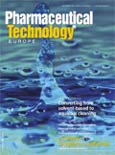Manufacture and Dissolution Studies of Lipid Spheres: Part II
Pharmaceutical Technology Europe
Previous articles have presented a general review of the different types of spheres that can be obtained using a rotary fluidized bed process.1,2 Part I of this study focussed on lipid spheres prepared using hydrogenated castor oil for formulations with low active drug content. The feasibility of the process and the main characteristics of spheres obtained were also studied. In Part II, formulations with higher concentrations of active drug are examined.
Part I of this study showed that the optimum release kinetics of lipid formulations are obtained using hydrogenated castor oil (HCO) with theophylline and polyvinylpyrrolidone (PVP) when ethanol is used as the pulverization liquid.3 In this second part, formulations containing a higher active drug range were tested and summarized (Table I).
When ethanol was used as the solvent (batches ML13 and PE3), it took a long time to obtain both very small spheres and a significant amount of fine fraction powder. In terms of process feasibility, the best results were obtained when water was used as the pulverization liquid with formulations containing a high theophylline content.

Figure 1 and 2.
For batches using water as the solvent, and for the majority of smaller fractions (sphere size ,0.315 mm) for formulations using ethanol, the study showed a regular distribution of the different fractions between 0.315–0.8 mm (Figures 1-4). The morphological study highlighted a regular and spherical aspect for all batches with sphericity coefficients close to 1 (1.094 for batch T14 and 1.029 for batch T15) (Figures 5 and 6).

Table I: Formulations and main results of spheres with a high percentage of active drug associated to lipidic excipient.
In vitro dissolutions were conducted using the paddle method on spheres of 300 mg with sizes ranging from 0.315–0.80 mm. Similar profiles were observed regardless of batch size or the percentage of active drug (Figures 7 and 8). Batches T14 and T15, which had the same formulations, showed particularly good reproducibility.
As in Part I of the study, lipid spheres formulated with HCO retain their matrix properties (in terms of delay of drug dissolution), even with a higher percentage of active drug. All dissolution profiles studied demonstrated good kinetic release reproducibility of the active drug from spheres, regardless of the batch size manufactured. This may confirm the benefit of using HCO as a lipid component for manufacturing spheres using the rotary fluidized bed process.4 This lipid component helped to produce spheres with good reproducibility. The spheres obtained presented good quality morphological aspects and prolonged drug release profiles corresponding to "micromatrix" components.

Figures 3 - 8.
References
1. P. Gauthier and J.M. Aiache, "Applications of Rotary Fluidized Bed Processing, Part I: Manufacturing Spheres," Pharm. Technol. Eur. 13(9) 22-34 (2001).
2. P. Gauthier and J.M. Aiache, "Applications of Rotary Fluidized Bed Processing, Part II: Fizzy Spheres," Pharm. Technol. Eur. 13(10) 32-37 (2001).
3. P. Gauthier and J.M. Aiache, "Manufacture and Dissolution Studies of Lipid Spheres: Part I," Pharm. Technol. Eur. 15(10) 55-66 (2003).
4. J. Swarbrick and J.C. Boylan, The Encyclopedia of Pharmaceutical Technology, Volume 7 (Marcel Dekker, Inc., New York, New York, USA, 1992) p 484.

Drug Solutions Podcast: A Closer Look at mRNA in Oncology and Vaccines
April 30th 2024In this episode fo the Drug Solutions Podcast, etherna’s vice-president of Technology and Innovation, Stefaan De Koker, discusses the merits and challenges of using mRNA as the foundation for therapeutics in oncology as well as for vaccines.
Pharmaceutical Tariffs Are Imminent: How Industry is Bracing for Impact
April 16th 2025On April 14, 2025, the Trump Administration launched a national security-driven investigation into pharmaceuticals, a move that will likely result in tariffs being placed on pharmaceutical drugs, ingredients, and other components that are imported from outside of the United States.